[NOW WITH NEW VISUALIZATION: see below]
Planets around other stars, exoplanets, have given me a long-running case of boredom – how long can you sustain OMG LOOKIT THAT PLANET HAS TWO SUNS? not long. I keep writing about them anyway. I do it because 1) sometimes somebody pays me to; and 2) the planets may or may not be interesting in themselves but the systems they’re in OMG THAT PLANET ISN’T GOING AROUND ITS SUN’S EQUATOR IT’S GOING OVER THE POLES! cause serious anti-Copernican shock. That is, though we’ve learned we’re not special in the universe, OMG NOT ONLY ARE WE SPECIAL AFTER ALL WE’RE APPARENTLY THE ONLY ONE THERE IS!
NASA and the ground-based planet hunters are fixated on finding another earth but — aside from the rigors of proving habitability — all they’ve found so far is not us. The most common exoplanets, of the thousands found so far, are bigger than Earth and smaller than Neptune; they’re called super-Earths or sometimes sub-Neptunes and up to half the sun-like stars have them. Our solar system has none (0, zero) of them. But being on an unlikely planet isn’t all that amazing.
What’s amazing is that no other solar system – more properly, planetary system – looks anything like ours. True, the two main planet-finding techniques are best at systems with exoplanets close to their stars. And if these techniques were looking at the solar system, they’d likely find the inner terrestrials and miss the outer giants. But never mind because the planetary systems they’re finding so far could give you a solid case of CAPS-LOCK.
These are all drawings but you can believe them — they’re based on exquisitely-measured observations and classical physics. If I were artistically adept and knew how to use the software, I’d draw these out myself just for the fun of doing it, also for the pleasure of being able to bypass the uncrop-able NASA images.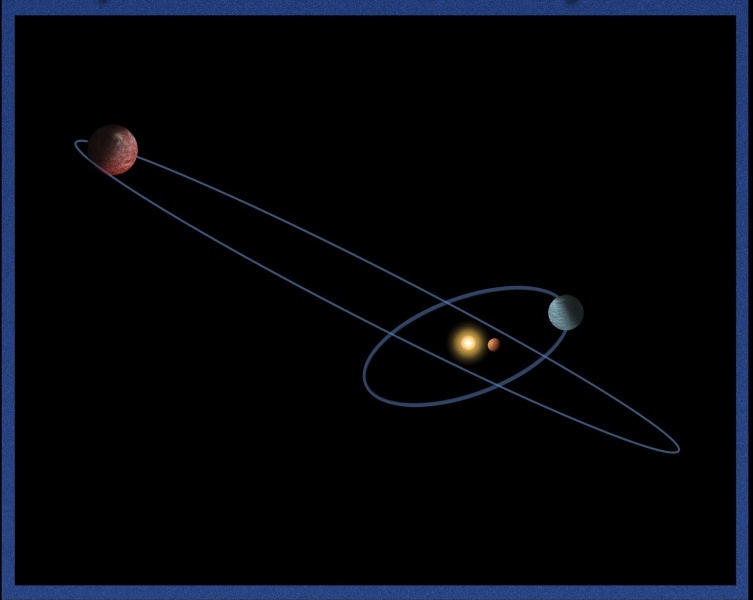 The one above is the planetary system around the star, Upsilon Andromedae. Those planets are all about the size of Jupiter; their years range from 4 days to 10-plus years. This is just wrong, right? All planets are supposed to be in tidily concentric orbits in the same plane, right? Flat, like a CD. This looks like a four-year old drew it. Astronomers’ explanation is that some other planet in the system probably went rogue and smacked that big red one out of alignment.
The one above is the planetary system around the star, Upsilon Andromedae. Those planets are all about the size of Jupiter; their years range from 4 days to 10-plus years. This is just wrong, right? All planets are supposed to be in tidily concentric orbits in the same plane, right? Flat, like a CD. This looks like a four-year old drew it. Astronomers’ explanation is that some other planet in the system probably went rogue and smacked that big red one out of alignment. 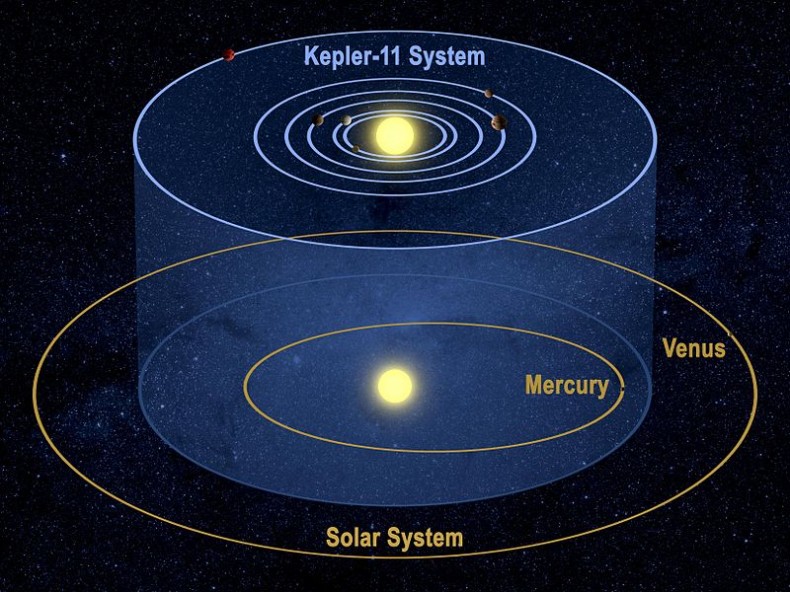 This is the Kepler-11 system. You know how, in our solar system, Venus is infernally hot and Mercury is unspeakably close to the sun? and how in the old, best theory and even intuitively, no planet would form that close to its star? because if it were that close, wouldn’t it just fall in? The Kepler-11 system nevertheless managed five super-Earths inside a Mercury orbit and an odd sixth inside Venus’s. Nobody knows how Kepler-11’s super-Earths got so close together or stayed close to their star. Astronomers are having the usual nature/nurture argument: were they born like that? or did something happen to them?
This is the Kepler-11 system. You know how, in our solar system, Venus is infernally hot and Mercury is unspeakably close to the sun? and how in the old, best theory and even intuitively, no planet would form that close to its star? because if it were that close, wouldn’t it just fall in? The Kepler-11 system nevertheless managed five super-Earths inside a Mercury orbit and an odd sixth inside Venus’s. Nobody knows how Kepler-11’s super-Earths got so close together or stayed close to their star. Astronomers are having the usual nature/nurture argument: were they born like that? or did something happen to them? 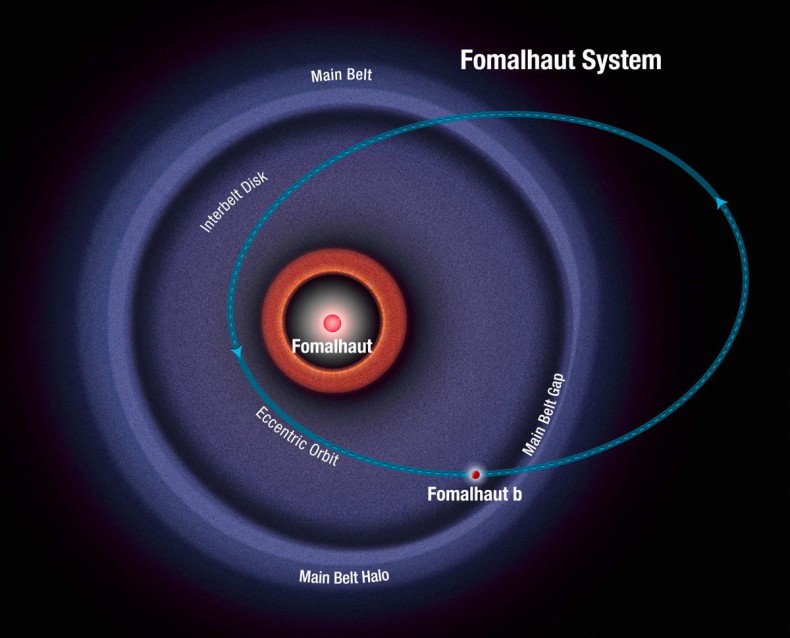 This is Fomalhaut’s system. Ignore all those belts — the system is still apparently forming up and some of those belts might coagulate into planets. The one planet that’s coagulated so far is Fomalhaut b and it too, is just wrong. Our own righteous planets go around the sun in orbits that are nearly circular and that seems normal, it’s the way gravity would naturally operate. It wouldn’t pull in hard half the year and lose interest the other half. Fomalhaut b is just bug-nuts: astronomers think its orbit might even flip over and go backward. And its year is 1,700 years long. It couldn’t have been born that way; like the Upsilon Andromedae system, something must have happened to it.
This is Fomalhaut’s system. Ignore all those belts — the system is still apparently forming up and some of those belts might coagulate into planets. The one planet that’s coagulated so far is Fomalhaut b and it too, is just wrong. Our own righteous planets go around the sun in orbits that are nearly circular and that seems normal, it’s the way gravity would naturally operate. It wouldn’t pull in hard half the year and lose interest the other half. Fomalhaut b is just bug-nuts: astronomers think its orbit might even flip over and go backward. And its year is 1,700 years long. It couldn’t have been born that way; like the Upsilon Andromedae system, something must have happened to it. 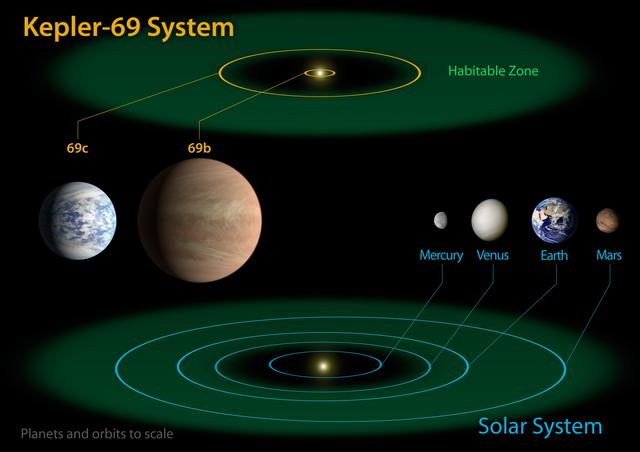 This is the Kepler-69 system. Instead of a bunch of little planets way too close to their star, like Kepler-11, it has two big planets way too close in. The bigger one is called a super-Earth but I think it’s more like a sub-Neptune; its year lasts 13 days. Big planets are fluffy, gaseous, and are supposed to be on the outside of the system; the little dense rocky planets are supposed to be on the inside. Isn’t that what gravity does? have the low-density stuff farther away and the high-density stuff close in? Yes, it does. (And remember that NASA’s only showing you the inner solar system here; a scale drawing of the whole solar system would have the Neptunes and Jupiters out in East Jesus somewhere.)
This is the Kepler-69 system. Instead of a bunch of little planets way too close to their star, like Kepler-11, it has two big planets way too close in. The bigger one is called a super-Earth but I think it’s more like a sub-Neptune; its year lasts 13 days. Big planets are fluffy, gaseous, and are supposed to be on the outside of the system; the little dense rocky planets are supposed to be on the inside. Isn’t that what gravity does? have the low-density stuff farther away and the high-density stuff close in? Yes, it does. (And remember that NASA’s only showing you the inner solar system here; a scale drawing of the whole solar system would have the Neptunes and Jupiters out in East Jesus somewhere.)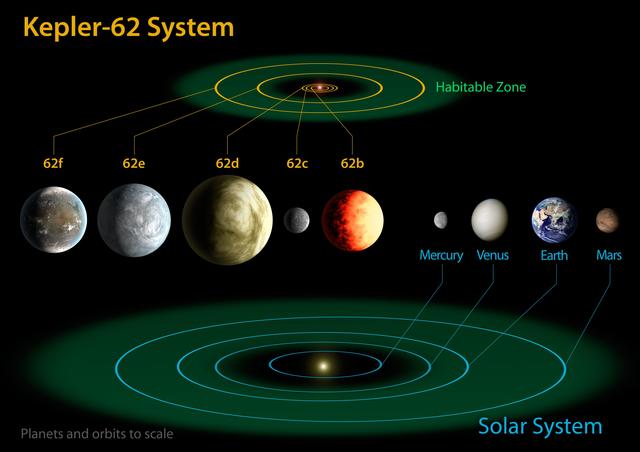 And here, for good measure, is the Kepler-62 system. It’s got a bunch of super-Earths and one little guy, all inside Venus’s orbit. One explanation for how to get that many planets that close to the star is that the original gas cloud from which the whole star/planetary system formed was much denser in the middle than the one from which the solar system probably formed. Or else those planets formed farther out and migrated toward the center in an orderly manner. Neither explanation seems particularly convincing.
And here, for good measure, is the Kepler-62 system. It’s got a bunch of super-Earths and one little guy, all inside Venus’s orbit. One explanation for how to get that many planets that close to the star is that the original gas cloud from which the whole star/planetary system formed was much denser in the middle than the one from which the solar system probably formed. Or else those planets formed farther out and migrated toward the center in an orderly manner. Neither explanation seems particularly convincing.
If the flat, circular, dense-inside/fluffy-outside solar system is as hard-wired in your brain as it is in mine (and in astronomers’), and if none of these systems seem reasonable, and if you’re worrying about losing the faith you placed in Isaac Newton and Johannes Kepler, then try this most wonderful game, Super Planet Crash.  This is a screen shot of my own personally-created solar system. I failed. You make the planets the size you want them to be and place them where you want them, then set gravity loose on the whole thing. If your planetary system lasts 500 years, you’re home free; and after that the most points wins. My next solar system lived 76 years before interplanetary catastrophe. But Kepler-62? 500 years and 36,358 points. And Kepler-11? 500 years and 102,171 points. Apparently gravity knows how to win, and within the constraints of winning, PLAYS THE GAME HOWEVER IT DAMN PLEASES.
This is a screen shot of my own personally-created solar system. I failed. You make the planets the size you want them to be and place them where you want them, then set gravity loose on the whole thing. If your planetary system lasts 500 years, you’re home free; and after that the most points wins. My next solar system lived 76 years before interplanetary catastrophe. But Kepler-62? 500 years and 36,358 points. And Kepler-11? 500 years and 102,171 points. Apparently gravity knows how to win, and within the constraints of winning, PLAYS THE GAME HOWEVER IT DAMN PLEASES.
____
UPDATE: I just found another fatally attractive website called Exovis that lets you watch known exoplanetary systems going about their business. It starts with the solar system; then just use the Up and Down arrows on your keyboard. A lot of these guys are normal. A lot of them profoundly aren’t.
__________
Photo credits, in order: planetary systems found in 2012 – NASA Ames/UC Santa Cruz; Upsilon Andromedae’s credits are on the picture; Kepler-11 – NASA/Tim Pyle; Fomalhaut – NASA / ESA / A. Feild (STScI); Kepler-69 – NASA/Ames/JPL-Caltech; Kepler-62 – NASA/Ames/JPL-Caltech; Super Planet Crash screen shot of catastrophe
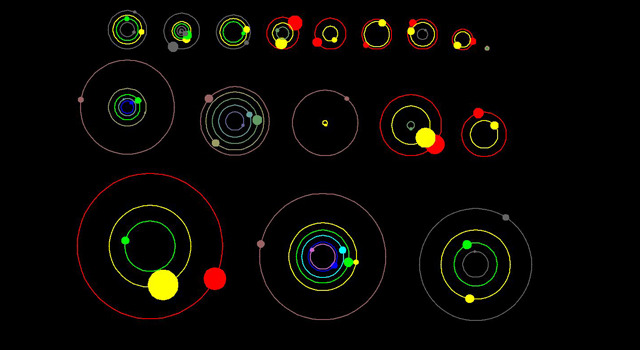
One thought on “Anti-Copernican Shock”
Comments are closed.